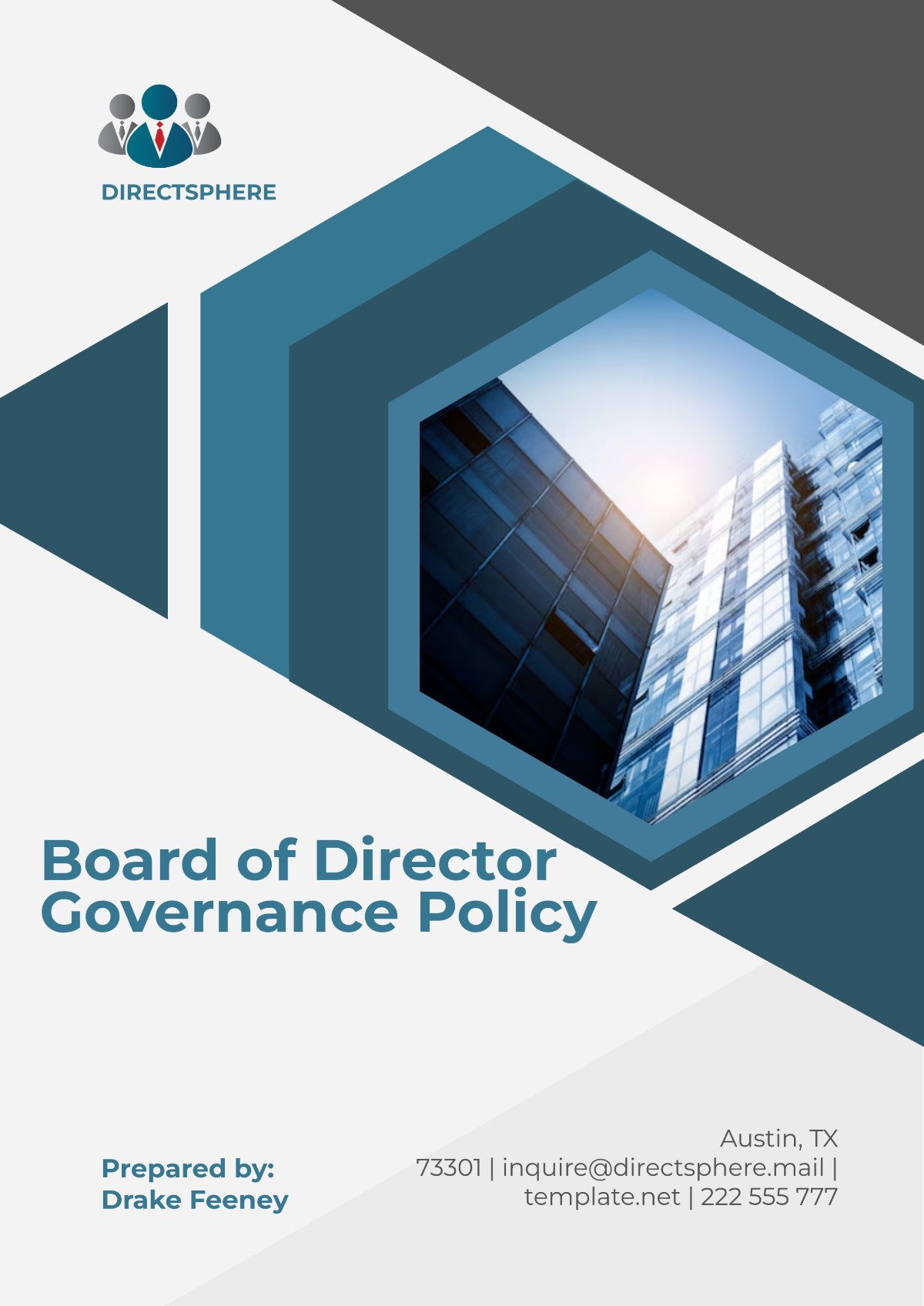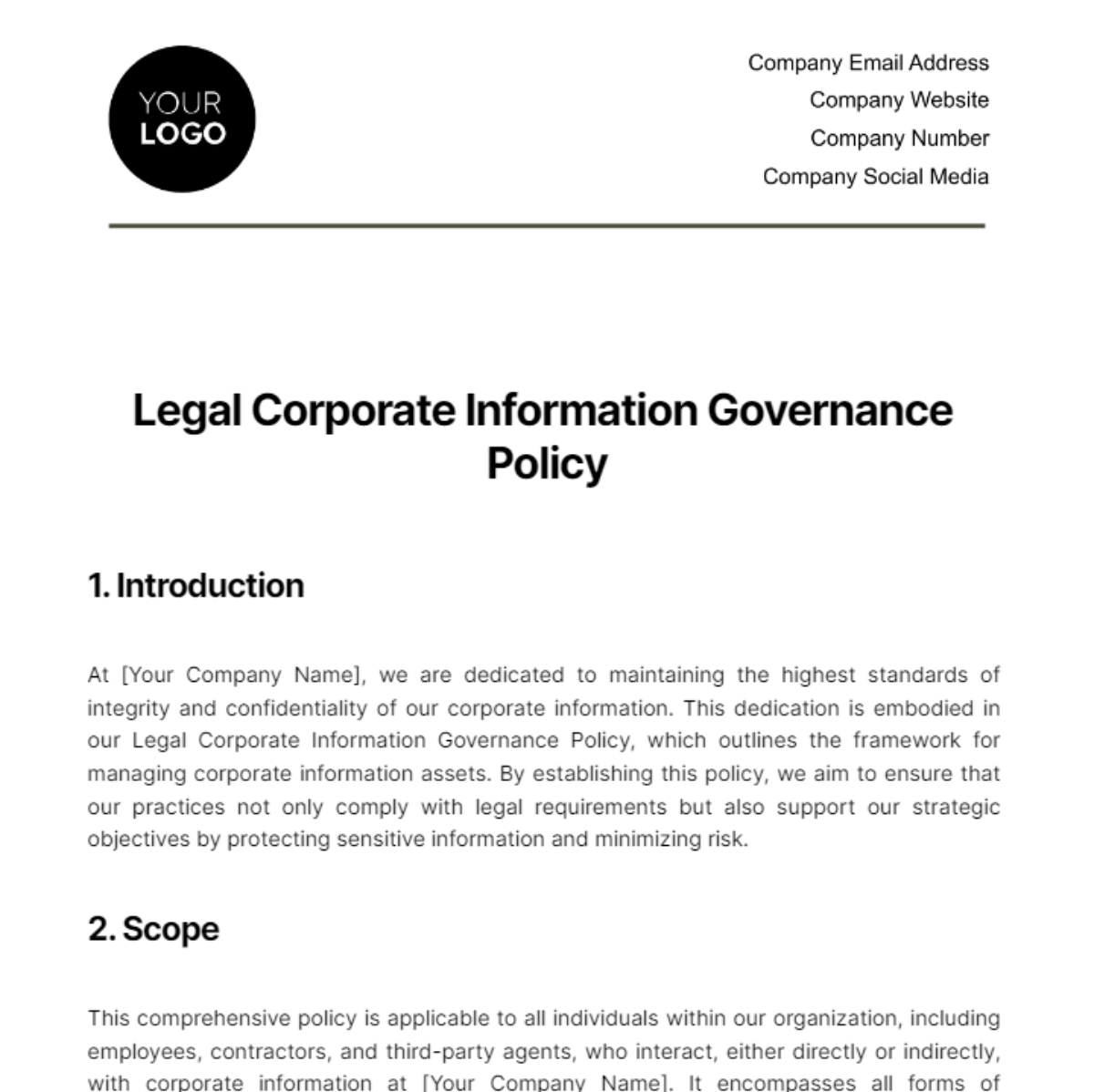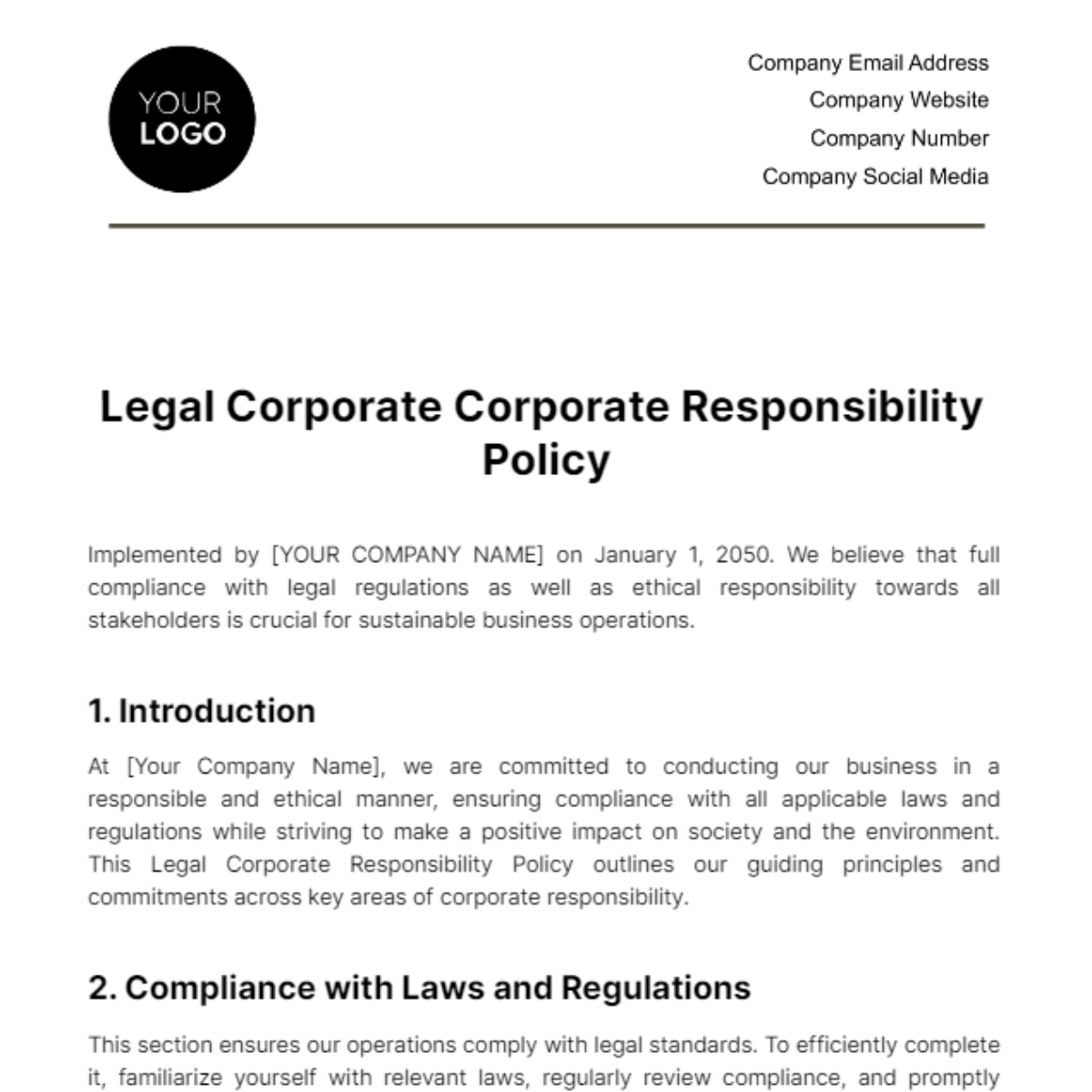Board of Director Governance Policy
1. Introduction
1.1 Purpose
The purpose of this Board of Director Governance Policy is to establish the principles and guidelines that govern the Board of Directors (the "Board") of [Your Company Name]. This policy is critical in ensuring that the Board of Directors effectively governs the company and works to create long-term value for its shareholders, employees, customers, and other stakeholders. The policy sets the framework for transparency, accountability, and compliance with all applicable laws and regulations. It also ensures that directors uphold the highest standards of ethics and integrity while fulfilling their fiduciary responsibilities.
This document provides the basis for the Board’s structure, duties, and responsibilities, detailing how the company’s Board should be composed, how meetings are conducted, and the procedures for evaluating its performance. By adhering to these guidelines, the Board will help to guide [Your Company Name] toward achieving its strategic objectives while maintaining corporate responsibility and sound risk management practices.
1.2 Scope
This policy applies to all individuals serving on the Board of Directors of [Your Company Name], including independent directors, non-executive directors, and executive directors. It governs all activities related to Board governance, including the decision-making processes, performance evaluations, and the oversight of management. The policy also covers Board meetings, committee structures, conflict resolution, and compliance with relevant regulations, ensuring that the Board members act in the best interest of the company, stakeholders, and shareholders.
Additionally, the Board is responsible for establishing and reviewing corporate governance frameworks, including compliance with the company’s bylaws, industry standards, and external regulations. It also emphasizes the need for continuous improvement and adherence to best practices in corporate governance.
1.3 Governance Framework
The governance framework ensures that the Board acts with a sense of responsibility and accountability in fulfilling its oversight duties. The Board will work closely with senior management to define, communicate, and implement the company's strategy, while also providing independent oversight. It will also ensure that management has the resources, systems, and support required to execute this strategy effectively.
This governance structure must be periodically reviewed to ensure that it remains adaptable and capable of meeting the challenges posed by evolving market conditions, regulatory changes, and shareholder expectations. The Board is also committed to fostering a culture of transparency and ethical behavior, which aligns with the values and mission of [Your Company Name].
2. Board Structure
2.1 Composition of the Board
The Board of Directors at [Your Company Name] will consist of a diverse group of individuals who collectively bring a wide range of experiences, expertise, and perspectives to the company. This will include individuals with deep knowledge of corporate governance, finance, law, operations, and the specific industries in which the company operates. The following types of directors will be appointed to ensure a balanced and effective Board structure:
Independent Directors: A majority of the Board members must be independent from the company’s management. Independent directors provide impartial judgment and can objectively evaluate and challenge the company’s strategy and decisions. It is recommended that at least [5] independent directors serve on the Board to ensure robust oversight.
Non-Executive Directors: Non-executive directors, although not involved in day-to-day operations, play a vital role in guiding the Board through strategic decision-making and risk management. These directors are essential for fostering a culture of accountability.
Executive Director(s): The CEO and other key members of management may serve as executive directors, contributing their operational expertise and understanding of the company’s internal workings to inform the Board's decision-making. The CEO will typically serve as the Chairman of the Board unless otherwise specified.
Board Committees: The Board will have various committees, each designed to address specific areas of governance. These committees include:
Audit Committee: Responsible for overseeing financial reporting and risk management.
Compensation and Nomination Committee: Handles executive compensation, recruitment, and succession planning.
Governance and Risk Committee: Oversees risk management processes and ensures that governance practices are in line with best practices.
Sustainability and Ethics Committee: Ensures the company is meeting its sustainability targets and adhering to ethical standards.
These committees are crucial for the effective functioning of the Board, as they allow directors to focus on specific areas of concern and expertise.
2.2 Qualifications of Board Members
Board members should be selected based on their ability to contribute to the overall success of [Your Company Name]. Specific criteria for selection include:
Experience in Business Management: Directors should have substantial experience in senior leadership positions, including CEO or other senior executive roles. They should possess a comprehensive understanding of financial management, business operations, strategic planning, and risk management.
Industry Knowledge: It is important that directors have experience within the industry in which [Your Company Name] operates. This ensures that the Board can provide informed insights into the challenges and opportunities faced by the company and its competitors. Directors with experience in related industries can also bring fresh perspectives.
Diversity: The Board actively promotes diversity in all aspects, including gender, race, nationality, and cognitive diversity. A diverse Board enhances decision-making by considering various viewpoints and creating an environment conducive to innovation and effective problem-solving.
Independence: To ensure objectivity and impartiality, the majority of directors must be independent from the company’s management. Directors should have no material relationship with the company, either directly or indirectly, that could affect their independent judgment.
In selecting new Board members, the Compensation and Nomination Committee will review the needs of the Board and evaluate candidates based on their alignment with the company’s current and future strategic objectives.
2.3 Term Limits and Rotation
To ensure a continuous influx of new ideas and perspectives, the Board will implement term limits for its directors. Directors may serve for a maximum of [8] years, which can be divided into two terms of [4] years each. After serving two consecutive terms, a director must take a one-term break before being considered for re-election to the Board. This policy helps maintain a balance between continuity and the introduction of fresh perspectives.
Regular rotation of directors ensures that the Board remains dynamic, free from complacency, and responsive to changes in the market and industry. This process allows for the incorporation of new skills, knowledge, and experience into the Board’s decision-making processes.
3. Roles and Responsibilities of the Board
3.1 Strategic Oversight
The Board is responsible for providing strategic direction to [Your Company Name] while ensuring that management implements the company’s long-term goals. The Board must ensure that the company has a comprehensive strategic plan and that resources are allocated effectively to achieve its objectives. This includes:
Reviewing and approving the company’s long-term goals, which may include increasing revenues by [10]% annually, expanding into new markets, or launching new product lines.
Ensuring that the strategic plan includes measurable key performance indicators (KPIs) and milestones to track progress.
Reviewing market conditions, competitive landscapes, and technological advancements to adjust the strategic direction when necessary.
The Board’s strategic oversight is an ongoing responsibility and requires frequent updates from management on the implementation and performance of the strategic plan.
3.2 Financial Oversight
The Board has a fiduciary duty to oversee the financial health and stability of the company. This oversight involves regular monitoring of financial reports, audits, and management’s adherence to internal controls. The Board will ensure that:
The annual budget of the company is approved, including anticipated revenues of [500 million dollars] and projected expenditures of [450 million dollars] for the next fiscal year.
Financial statements are audited annually by external auditors to ensure accuracy and compliance with generally accepted accounting principles (GAAP).
There is a robust internal control system to prevent fraud, mismanagement, and errors. This includes overseeing the company’s financial reporting processes and assessing risks related to financial performance.
Additionally, the Board will ensure that executive compensation aligns with the company’s financial goals and shareholder interests, with annual bonuses based on meeting pre-established financial performance targets such as a [5]% return on equity.
3.3 Risk Management
Risk management is essential to the company’s long-term viability. The Board is responsible for ensuring that risk management systems are in place and that the company identifies, assesses, and mitigates risks appropriately. The Board will:
Review the company’s risk management policies, including a detailed risk register that identifies key risks such as cyber threats, supply chain disruptions, and regulatory compliance risks.
Ensure that the company has adequate insurance coverage, such as [10 million dollars] in liability insurance, to mitigate unforeseen risks.
Monitor the implementation of contingency plans in the event of crises such as natural disasters, economic downturns, or reputational damage.
The Board’s role is to guide management on risk appetite and ensure that risk mitigation strategies are aligned with the company’s overall objectives.
3.4 Corporate Governance
The Board is responsible for overseeing corporate governance to ensure that the company operates with transparency and in compliance with legal and regulatory requirements. This includes:
Regularly reviewing the company’s governance policies, such as its code of ethics, anti-corruption policies, and conflict-of-interest policies.
Ensuring that the company adheres to all applicable laws, including securities regulations, labor laws, and environmental regulations.
Implementing and enforcing ethical standards for Board members and employees, ensuring that [Your Company Name] is a trusted leader in corporate responsibility.
3.5 Stakeholder Engagement
The Board must ensure that [Your Company Name] engages with its stakeholders in a transparent and meaningful way. This includes shareholders, employees, customers, suppliers, regulators, and the communities in which the company operates. Key responsibilities include:
Approving shareholder communication strategies, such as quarterly earnings calls, annual reports, and shareholder meetings.
Ensuring the company meets sustainability targets, including reducing carbon emissions by [15]% over the next [5] years.
Overseeing employee relations programs that promote diversity, equity, and inclusion, ensuring that the company maintains a positive workplace culture.
3.6 Executive Oversight
One of the Board’s most important roles is to oversee the performance and compensation of the company’s executive team, particularly the CEO. The Board will:
Review and approve the CEO’s performance, based on criteria such as the achievement of financial targets, market expansion, and leadership effectiveness.
Approve executive compensation, ensuring that it is aligned with long-term shareholder value creation. For example, the CEO’s bonus may be tied to an increase in shareholder value of [5]% annually.
Approve succession plans to ensure that the company has a pipeline of talent ready to step into senior leadership roles.
4. Board Meetings
4.1 Frequency of Meetings
The Board of Directors will meet at least [quarterly] throughout the fiscal year. In addition to regular meetings, special meetings may be convened when urgent matters arise, such as a potential acquisition or a major financial decision. The exact schedule for the year will be determined at the start of each fiscal year, with specific dates proposed to ensure maximum participation from Board members.
4.2 Board Agenda
The agenda for each Board meeting will be determined in advance, typically [two] weeks before the scheduled meeting. The agenda will be prepared by the Board Chair in collaboration with the CEO, the company’s legal counsel, and the Chair of each committee. Key items on the agenda will include:
Review and approval of the minutes from previous meetings
Discussion of the company’s financial performance, including balance sheets, profit and loss statements, and cash flow reports
Updates on strategic initiatives, risks, and market developments
Reports from committees, including any recommendations for approval or further action
The goal of each meeting is to ensure that the Board remains fully informed about the company’s performance and is able to make decisions in a timely and effective manner.
4.3 Board Materials
Directors will receive all necessary meeting materials at least [7] days before each meeting. These materials will include detailed reports from management, financial statements, updates on strategic initiatives, and any other documents necessary for informed decision-making. The quality and completeness of the materials provided will be maintained at a high standard to ensure that Board members are prepared to discuss the matters at hand.
4.4 Voting Procedures
Decisions made by the Board are generally based on a majority vote. Each director has one vote, and in the event of a tie, the Chair of the Board will have the casting vote. For certain resolutions, such as amendments to the company’s bylaws or approval of major acquisitions, a higher voting threshold may be required, as outlined in the company’s Articles of Incorporation.
5. Director Compensation
5.1 Compensation Structure
The compensation of directors at [Your Company Name] will be designed to attract and retain highly qualified individuals while ensuring that the company’s financial resources are used efficiently. The compensation structure will include:
Annual Retainer: Directors will receive an annual retainer of [50,000 dollars], payable quarterly, to compensate for their time and expertise.
Committee Fees: Directors who serve on committees will receive additional fees, which may vary depending on the committee’s workload. For example, committee members might receive [5,000 dollars] per committee meeting, while the committee chair could receive [10,000 dollars] per meeting.
Equity Compensation: To align directors’ interests with those of shareholders, directors will receive equity-based compensation. This could include stock options or restricted stock grants with a value of up to [100,000 dollars] annually.
The overall goal of the compensation structure is to ensure that directors are incentivized to act in the best interests of the company and its shareholders.
5.2 Evaluation and Adjustment
The Board's compensation structure will be reviewed annually by the Compensation and Nomination Committee. This review will assess whether the compensation is competitive within the industry and whether it effectively incentivizes directors to meet the company’s long-term objectives. Adjustments may be made to ensure that the Board remains fully aligned with the company’s goals and the interests of its stakeholders.
6. Conflicts of Interest
6.1 Disclosure of Conflicts
All directors are required to disclose any potential conflicts of interest that could impair their ability to act impartially. Directors must disclose such conflicts promptly and fully to the Board. This includes, but is not limited to, financial interests, relationships with competitors, or personal connections that may create conflicts.
6.2 Management of Conflicts
When a conflict of interest is identified, the Board will work with the affected director to resolve the issue. This may include asking the director to recuse themselves from certain discussions or votes related to the conflict. If necessary, the Board may seek advice from legal counsel or an independent third party to ensure that any decision made is in the best interest of the company.
6.3 Prohibited Activities
Directors are prohibited from engaging in activities that would undermine the integrity of the company or conflict with its interests. Any director found to be in violation of these standards may face disciplinary action, including removal from the Board.
7. Evaluation of the Board’s Performance
7.1 Self-Assessment
To maintain a high level of effectiveness, the Board will conduct a self-assessment annually. This evaluation will focus on various aspects, including strategic planning, oversight of risk management, decision-making processes, and overall contributions.
7.2 External Evaluation
Periodically, the Board may engage an external consultant to conduct a thorough and independent evaluation of its performance. This ensures that the Board's governance practices are aligned with industry standards and best practices. The external evaluation will be based on criteria such as the Board’s ability to support strategic goals, its financial oversight effectiveness, and its responsiveness to shareholder concerns.
7.3 Action Plan for Improvement
Following the self-assessment or external evaluation, the Board will formulate an action plan to address any identified weaknesses or areas for improvement. The plan will include specific steps to enhance Board performance, such as increasing meeting efficiency, improving communication with management, or addressing skills gaps among Board members. The Board Chair will oversee the implementation of this action plan, and progress will be reviewed periodically to ensure that the necessary improvements are achieved. This proactive approach fosters a culture of continuous improvement within the Board, ensuring that it remains responsive to both internal and external challenges.
8. Board Member Education and Development
8.1 Ongoing Education
To ensure that all members of the Board are fully equipped to carry out their governance responsibilities, [Your Company Name] will provide ongoing education and training opportunities. This is particularly important given the rapidly changing regulatory landscape, evolving industry trends, and advancements in technology. Education will cover topics such as:
Corporate governance best practices
Financial reporting and accounting standards
Regulatory compliance, including changes in securities laws
Risk management frameworks and crisis management
Sustainability and corporate social responsibility (CSR)
Innovation, technology, and digital transformation
Education programs may take the form of in-person workshops, virtual seminars, webinars, and conferences. Board members will be expected to participate in at least one training session annually, with the company covering all associated costs.
8.2 Mentoring and Peer Learning
In addition to formal education, the Board encourages a culture of mentoring and peer learning. New directors will be paired with experienced members of the Board for mentorship, ensuring they have the guidance needed to understand the company’s operations and the governance structure. This mentorship will allow for a smoother transition into Board responsibilities and will help new directors gain insights from seasoned members.
The mentoring process will focus on sharing knowledge related to governance issues, strategic planning, financial oversight, and effective collaboration with senior management. Additionally, peer learning groups may be established within the Board to facilitate discussions and knowledge sharing on specific issues or projects.
8.3 Board Member Self-Improvement
Board members are encouraged to continuously evaluate and improve their skills and knowledge base. Directors should proactively seek out opportunities to expand their knowledge and engage with industry experts. This commitment to self-improvement ensures that the Board remains capable of guiding the company through complex and dynamic business environments.
9. Corporate Social Responsibility (CSR) and Sustainability
9.1 Commitment to CSR
The Board of Directors is committed to promoting corporate social responsibility (CSR) as an integral part of [Your Company Name]'s overall business strategy. This commitment reflects the company’s responsibility to act as a good corporate citizen, balancing financial success with positive impacts on the environment, society, and local communities. As part of the CSR initiatives, the Board will oversee the implementation of programs and policies aimed at:
Supporting environmental sustainability by reducing the company’s carbon footprint, including achieving a [20]% reduction in CO2 emissions by [2060].
Encouraging diversity and inclusion both within the company and in the communities it serves.
Contributing to social causes such as education, health care, and community development through philanthropy and employee volunteerism.
Promoting ethical business practices, including transparency in business dealings and adherence to anti-corruption laws.
The Board will also ensure that CSR strategies are integrated into the company’s strategic planning and that CSR performance is regularly monitored, evaluated, and reported.
9.2 Environmental Sustainability
In response to the global emphasis on environmental sustainability, the Board will oversee the company’s efforts to reduce its environmental impact. This includes adopting sustainable business practices across operations, supply chains, and product life cycles. Specific goals for sustainability may include:
Transitioning to renewable energy sources, such as solar or wind power, to reduce reliance on non-renewable resources.
Implementing waste reduction programs, including recycling and reducing material waste by [10]% annually.
Engaging suppliers and partners to adopt similar sustainability practices, creating a ripple effect throughout the supply chain.
The Board will ensure that these sustainability objectives are incorporated into the company’s corporate strategy, and progress will be reported annually to shareholders and stakeholders.
9.3 Ethics and Integrity
The Board holds itself and [Your Company Name] to the highest ethical standards. All Board members are expected to act with integrity, fairness, and transparency in all dealings. This includes:
Strict adherence to the company’s code of ethics, which governs the conduct of directors, employees, and business partners.
Zero tolerance for corruption, bribery, or unethical business practices in any form.
Promoting ethical decision-making at every level of the company, particularly in areas such as hiring, contracting, and financial reporting.
The Board will periodically review the company’s ethical guidelines and ensure that any potential violations are addressed promptly and appropriately. Regular ethics training will be provided to both Board members and employees to reinforce the importance of ethical behavior in every aspect of the company’s operations.
10. Confidentiality
10.1 Confidentiality Obligations of Board Members
All directors of [Your Company Name] are expected to maintain strict confidentiality regarding sensitive company information. This obligation extends beyond their term on the Board and remains in place after their departure. Confidential information includes, but is not limited to:
Financial data and projections
Strategic plans, including mergers, acquisitions, or divestitures
Employee information, including salaries and compensation packages
Customer and supplier details
Internal communications and Board discussions
Board members must not disclose confidential information to unauthorized parties or use it for personal gain. Any breach of confidentiality will be subject to immediate review and may result in disciplinary action, including removal from the Board and potential legal consequences.
10.2 Non-Disclosure Agreements (NDAs)
To further ensure the protection of sensitive information, directors will be required to sign a non-disclosure agreement (NDA) upon joining the Board. The NDA will clearly define the scope of confidential information and the penalties for disclosing it. The agreement will also outline the procedures for handling sensitive documents and digital communications.
11. Reporting and Accountability
11.1 Reporting to Shareholders
As part of its commitment to transparency, the Board will provide regular reports to shareholders, including quarterly and annual reports that detail the company’s financial performance, strategic initiatives, risks, and CSR efforts. The Board will also hold an annual general meeting (AGM) where shareholders can ask questions and discuss key issues.
These reports will include:
A letter from the CEO and Board Chair, summarizing the company’s performance and strategic outlook.
Financial statements audited by an independent auditor, including income statements, balance sheets, and cash flow statements.
A discussion of the company’s risk profile and mitigation strategies.
Updates on CSR programs and sustainability performance.
Shareholder feedback will be carefully considered by the Board, and management will take action to address concerns or recommendations as appropriate.
11.2 Transparency in Decision-Making
The Board is committed to ensuring that its decision-making process is transparent and in line with the principles of good governance. Directors are required to fully disclose any potential conflicts of interest before voting on decisions. In situations where there is a conflict of interest, the director will recuse themselves from voting, and the remaining Board members will make the decision.
Minutes from Board meetings will be recorded and made available to shareholders upon request. These minutes will provide a detailed account of decisions made, key discussions, and any actions taken.
11.3 Performance Accountability
The Board will hold itself accountable for the company’s performance and overall governance. Key performance indicators (KPIs) will be established annually, and the Board will be held responsible for meeting these targets. The CEO and other executive leaders will also be held accountable for their performance in achieving the company’s objectives.
Regular performance reviews will be conducted, focusing on both the financial health of the company and the effectiveness of its governance practices. The Board will make necessary adjustments based on performance data and shareholder feedback to ensure that the company remains on track to meet its long-term goals.
12. Amendments to the Governance Policy
12.1 Review and Revision Process
This Board of Director Governance Policy will be reviewed annually by the Governance and Risk Committee to ensure that it remains relevant and effective in guiding the Board’s activities. The committee will consider changes in the regulatory environment, best practices in governance, and the evolving needs of [Your Company Name].
If any amendments are required, they will be presented to the full Board for approval. Any changes to this policy must be voted on and approved by the Board, with a majority vote required for ratification. Additionally, shareholders may be informed of any significant changes to the policy at the annual meeting or through a formal communication.
12.2 Implementation of Amendments
Once approved, amendments to the Governance Policy will be communicated to all Board members and relevant stakeholders. The Board Chair will ensure that any necessary adjustments are made to the company's governance structures or processes to align with the updated policy.

















































